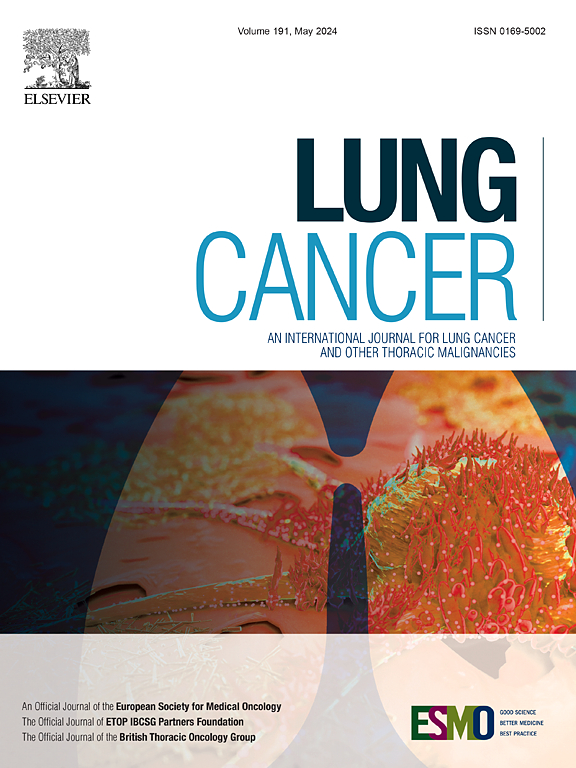Cell adhesion molecule-1 is a promising target for chimeric antigen receptors in lung adenocarcinoma
IF 4.4
2区 医学
Q1 ONCOLOGY
引用次数: 0
Abstract
Advances in targeted therapies, immune-checkpoint inhibitors, and chemo-immunotherapy combinations have improved survival in subsets of lung adenocarcinoma (LUAD) patients, yet novel treatments are needed for those who do not respond. We previously demonstrated that Cell Adhesion Molecule 1 (CADM1) is modulated by EMT-MET cycling in lung cancer cells, and mediates NK-mediated immune surveillance. In this study, CADM1 expression was confirmed on the cell surface, correlating with poor survival in LUAD patients, identifying it as a potential therapeutic target for chimeric antigen receptor (CAR) based approach. An anti-CADM1 chimeric antigen receptor (CAR) was developed, demonstrating robust CADM1-specific activity against lung cancer cells. CADM1-CAR-T cells exhibited a balanced composition of stem cell-like (TSCM), central memory (TCM), along with effector memory (TEM), and effector (TEFF) T cells, crucial for immediate and sustained tumor eradication. In NSG mouse models with orthotopic LUAD xenografts, CADM1-CAR-T cells inhibited tumor growth and extended survival compared to controls, with no effect on CADM1-negative xenografts. Interestingly, CADM1-CAR-T cells did not inhibit subcutaneous tumor growth but effectively reduced spontaneous metastases, underscoring their potential in metastatic LUAD. These findings establish CADM1 as a new target for CAR-T therapies, highlighting its promise for treating both primary and metastatic LUAD.
细胞粘附分子-1是肺腺癌嵌合抗原受体的一个有希望的靶点
靶向治疗、免疫检查点抑制剂和化学免疫联合治疗的进展提高了肺腺癌(LUAD)患者亚群的生存率,但对于那些没有反应的患者,需要新的治疗方法。我们之前证明了细胞粘附分子1 (CADM1)在肺癌细胞中受EMT-MET循环调节,并介导nk介导的免疫监视。在这项研究中,CADM1在细胞表面的表达被证实与LUAD患者的低生存率相关,并将其确定为基于嵌合抗原受体(CAR)方法的潜在治疗靶点。一种抗cadm1嵌合抗原受体(CAR)被开发出来,显示出对肺癌细胞强大的cadm1特异性活性。CADM1-CAR-T细胞表现出干细胞样(TSCM)、中枢记忆(TCM)、效应记忆(TEM)和效应T细胞(TEFF)的平衡组成,这对于立即和持续根除肿瘤至关重要。在原位LUAD异种移植的NSG小鼠模型中,与对照组相比,CADM1-CAR-T细胞抑制肿瘤生长并延长生存期,而对cadm1阴性的异种移植物没有影响。有趣的是,CADM1-CAR-T细胞没有抑制皮下肿瘤的生长,但有效地减少了自发转移,强调了它们在转移性LUAD中的潜力。这些发现确立了CADM1作为CAR-T疗法的新靶点,突出了其治疗原发性和转移性LUAD的前景。
本文章由计算机程序翻译,如有差异,请以英文原文为准。
求助全文
约1分钟内获得全文
求助全文
来源期刊

Lung Cancer
医学-呼吸系统
CiteScore
9.40
自引率
3.80%
发文量
407
审稿时长
25 days
期刊介绍:
Lung Cancer is an international publication covering the clinical, translational and basic science of malignancies of the lung and chest region.Original research articles, early reports, review articles, editorials and correspondence covering the prevention, epidemiology and etiology, basic biology, pathology, clinical assessment, surgery, chemotherapy, radiotherapy, combined treatment modalities, other treatment modalities and outcomes of lung cancer are welcome.
 求助内容:
求助内容: 应助结果提醒方式:
应助结果提醒方式:


